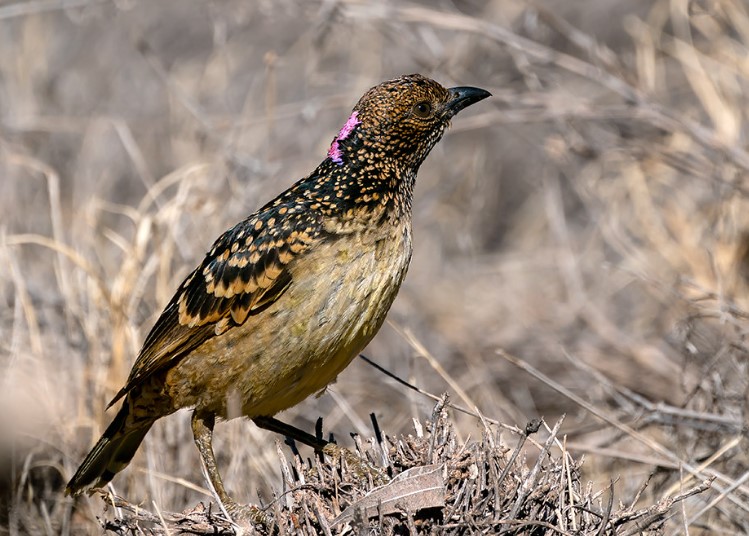The Western Bowerbird (Chlamydera guttata) belongs to the family Ptilonorhynchidae. There is a common endemic species among the species in Australia. In the desert hills and ranges of central and western Australia, the Western Bowerbird has replaced the Spotted Bowerbird. Both bower-builders and their behavior are similar, but the Western often raises its avenue of sticks between 160 and 200 mm above the ground. It has been argued that they are race variants of the same species because they resemble each other so much.
In spite of this, the Western Bowerbird is a much smaller and more colorful bird. There is a difference in shape and length between its bill and tail. Spotted birds have scalloped crowns, not streaked ones, and their mantles lack all traces of the plain patches characteristic of spotted birds. Neither of them intergrades near the northern Simpson Desert, where they almost meet.
Water and leafy trees provide shelter and food for Western Bowerbirds throughout their range, so they stay near breakaways with water. They pick drupes of sandalwood and mistletoe in shrubs and trees’ crowns, although they also consume insects. Figs (Ficus platypoda), are commonly found in pockets in many areas where the bird can be found.

Guttated Bowerbird is another name for it. Western Bowerbirds measure around 260–270 mm in length, but females are a bit larger. There is a broad nape bar of dense lilac plumes on the male bird, with a dusky crown, closely scalloped ochre, and leaden plumes.
The rest of the upper body, wings, and short tail feather tips are dusky black, with finer spots of ochre along the mantle. The underparts of the bird are yellow-cream, faintly barred on the flanks and under the tail, and variably washed with russet; the face and throat are dusky, spotted ochre; the rest of the underparts are yellow-cream.
The eyes are brown in color. Black is the color of the bill, while yellow is the color of the mouth. Olive-grey is the color of the feet. Compared to the male, the female has a scalloped crown, a reduced nape bar, a more heavily spotted throat, and a longer tail. There is no immature nape bar. Western Bowerbirds have a similar call to spotted bowerbirds.
Between September and December are the nesting and breeding seasons. Traditionally, nests were formed in tree foliage 2–10 meters up in vertical forks made from loose twigs; liners were made from finer twigs and needles. A pair of pale gray-green eggs are usually laid by this bird, which is covered in occasional darker blotches and winding scrawls of brown.
Eggs measure about 32 x 26 mm in size and are oval in shape. Generally, Western Bowerbirds are found between Birksgate, Warburton, Macdonnell, and Jervois Ranges, and Pilbara, east to the edge of the Gibson Desert, and south to CueLeonora, Western Australia.
Read More: Regent Bowerbird (Sericulus chrysocephalus)
